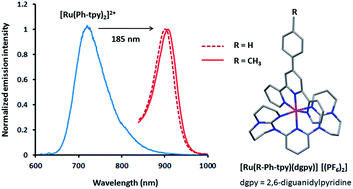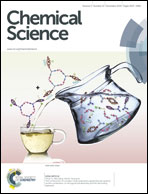Near infra-red emitting Ru(ii) complexes of tridentate ligands: electrochemical and photophysical consequences of a strong donor ligand with large bite angles†
Abstract
A novel N^N^N tridentate ligand dgpy (dgpy = 2,6-diguanidylpyridine) was synthesized by a Pd-catalyzed C–N bond-forming reaction. A novel family of [RuII(tpy')(dgpy)](PF6)2 (1 and 2) or [RuII(dpt')(dgpy)](PF6)2 (3 and 4) (tpy' = substituted-2,2′:6′,2′-terpyridine, dpt' = substituted-2,4-dipyrid-2′-yl-1,3,5-triazine) complexes are reported. The dgpy ligand (80%) and the heteroleptic complexes 1–4 (37–60%) were obtained in modest to good yields. The dgpy ligand and its complexes were fully characterized by a variety of techniques including X-ray crystallography and density functional theory (DFT). In cyclic voltammetric studies, the complexes exhibit a RuIII/II couple, which is 600–800 mV less positive than the RuIII/II couple in [Ru(tpy)2]2+. The 1MLCT absorption maxima of all the complexes (620–740 nm) are considerably red-shifted as compared to that of [Ru(tpy)2]2+ (474 nm). The 3MLCT emission maxima of complexes 1 and 2 are also red-shifted by about 270 nm compared to that of [Ru(tpy)2]2+ (629 nm) at room temperature (298 K), whereas the corresponding maxima for complexes 3 and 4 are shifted by about 330 nm at 77 K. The relative trends in redox potentials and 1MLCT maxima are in good agreement with DFT and TD-DFT calculations. Complexes 1 and 2 emit from a RuII-to-tpy 3MLCT state, which is rarely the emitting state at λ > 850 nm in [Ru(tpy)(N^N^N)]2+ complexes when the ancillary ligand is neutral. Complexes 1 and 2 also exhibit long excited-state lifetimes (τ ∼ 100 ns) at room temperature with associated quantum yield (Φ) of 0.001. The reported τ and Φ values are approximately 400–500 times and 1000 times higher compared to those of [Ru(tpy)2]2+ (τ = 0.25 ns, Φ ≤ 5 × 10−6), respectively. Complexes 3 and 4 emit from a RuII-to-dpt 3MLCT state, albeit only at 77 K (τ = 0.25 ns) due to rapid deactivation of their 3MLCT state according to the energy-gap law. The improved photophysical properties of the complexes are consequences of enlarged separation of the 3MLCT–3MC states, due to the strong donation and larger bite angles of the dgpy ligand.


 Please wait while we load your content...
Please wait while we load your content...